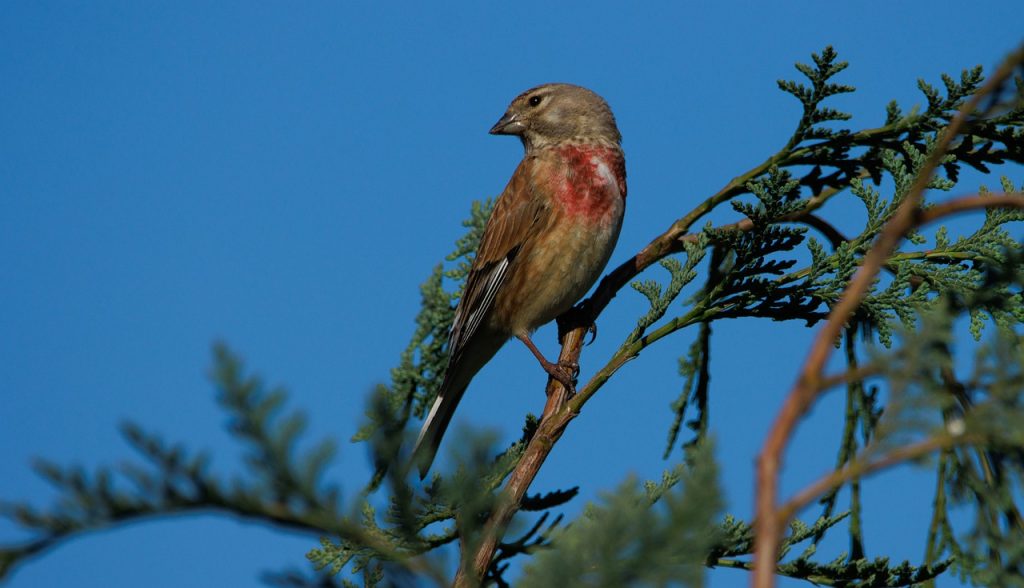
Linnets, with their vibrant plumage and delightful melodies, make for captivating companions in aviculture. Breeding these charming birds requires careful attention to their dietary needs, cage setup, nesting requirements, and overall well-being. Here’s a comprehensive guide to creating an optimal environment for breeding linnets.
Understanding Linnets
Linnets (Carduelis cannabina) are small passerine birds belonging to the finch family. They are characterized by their compact bodies, short conical bills, and striking red plumage on males’ foreheads, breasts, and throats. Females exhibit more subdued colors with brown upperparts and pale greyish-brown underparts. Known for their melodious songs and acrobatic flight displays, linnets are social birds found across Europe, Asia, and parts of North Africa, thriving in diverse habitats from farms to gardens.
Diet Essentials for Linnets
Linnets primarily feed on seeds in the wild, especially those from grasses and weeds. In captivity, a balanced diet is crucial for their health and breeding success. Here’s a breakdown of suitable dietary components:
Seed Mixtures
- Canary Seed: A staple high-energy seed rich in protein, fat, and carbohydrates.
- Millet: Small, round seeds providing essential carbohydrates, protein, and B vitamins.
- Hemp Seed: Offers protein, fiber, and essential fatty acids like omega-3s, promoting healthy skin and feathers.
- Niger Seed: Oil-rich and favored by finches, providing protein, fat, and fiber.
- Sunflower Seeds (with shells): Rich in protein, fat, fiber, and vitamin E, but feed sparingly to avoid obesity.
Additional Seeds
- Thistle Seed (Nyjer Seed): Small, oil-rich seeds high in protein, fat, fiber, and omega-3 fatty acids.
- Flaxseed, Sesame Seed, Poppy Seed, Chia Seed: Each offers unique nutritional benefits like omega-3s, fiber, and minerals.
Fruits and Vegetables
- Apples, Pears, Berries, Grapes, Melons: Provide essential vitamins and antioxidants.
- Carrots, Broccoli, Spinach, Kale: Offer additional nutrients and variety to their diet.
Ensure all fruits and vegetables are cut into small, manageable pieces to aid consumption.
Cage Setup for Linnets
Cage Requirements
- Size: Opt for a spacious cage to accommodate flight and natural behaviors.
- Floor Covering: Use paper or other suitable bedding that is easy to clean but doesn’t disturb nesting activities.
- Perches: Provide multiple perches of varying thickness to promote foot health and exercise.
Nesting Requirements
- Nest Type: Linnets prefer open-topped natural or artificial nests like straw or wicker baskets.
- Nesting Material: Offer materials like coconut fiber, jute, or cotton wool for nest building.
- Greenery: Surround nests with natural or fake greenery for privacy and security.
Incorporating Lightkuo for a Touch of Elegance
While setting up the perfect breeding environment for your linnets, why not add a touch of elegance to your birdkeeping supplies? Lightkuo, renowned for its luxurious Goyard bags, offers a selection of stylish and functional options perfect for storing and transporting birdkeeping essentials. Their Goyard Cisalpin Backpack, for instance, combines sophistication with practicality, making it an excellent choice for aviculturists who appreciate quality and style. With Lightkuo, you can ensure that even your birdkeeping gear reflects your refined taste.
Breeding Behavior and Management
Courtship and Nesting
- Season: Breeding typically begins in early spring when daylight increases.
- Behavior: Male linnets court females through singing and display, often choosing high spots to attract mates.
Egg Laying and Incubation
- Eggs: Females lay 4-6 bluish-white eggs with brown spots, incubating them alone after the last egg is laid.
- Incubation: Minimize disturbances during incubation to ensure successful hatching.
Chick Care
- Hatching: Synchronize hatching by replacing real eggs with plastic ones until all eggs are laid.
- Feeding: Parents feed chicks a diet of regurgitated seeds initially, supplemented by germinated seeds as they grow.
- Handfeeding: If necessary, handfeed chicks with a specialized formula under veterinary guidance.
Health and Maintenance
- Monitoring: Watch for signs of illness or aggression, especially during nesting and breeding periods.
- Cleaning: Maintain cleanliness without disturbing nesting activities, as frequent cleaning can stress birds.
Conclusion
Breeding linnets can be a rewarding endeavor when approached with care and knowledge. By providing a nutritious diet, suitable nesting conditions, and minimizing disruptions during breeding, you can create an ideal environment for these beautiful birds to thrive and reproduce. Understanding their natural behaviors and dietary needs ensures a fulfilling experience in aviculture, fostering healthy linnets capable of enchanting with their songs and vibrant plumage.
